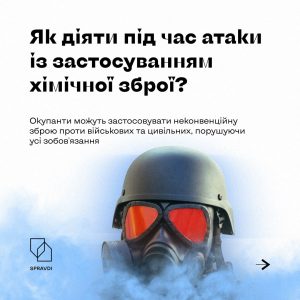Against the background of news that the occupier dumped an unknown poisonous substance on Mariupol, the Center for Strategic Communications SPRAVDI provides instructions on how to protect yourself. This was reported on the telegram channel of the Center.
We remind you that the information on the use of chemical weapons has not been confirmed yet. However, it is better to know the rules of what to do during a chemical attack.
Official chemical attack reports
Follow reports from official sources and strictly follow the instructions they provide. Such messages should include:
– announcement of signs of use of chemical weapons;
– the main features of the detected chemicals;
– the territory of their application;
– recommendations for injury prevention and primary care;
– ways to address victims and emergency numbers;
– instructions for people who need to be evacuated from the affected area;
– Once confirmation of the use of specific chemical weapons, official notices and instructions will be detailed.
Basic physical symptoms of chemical use
– miosis (excessive narrowing of the pupils);
– disorientation and sweating;
– twitching and convulsions;
– irritation of the respiratory tract and difficulty breathing;
– eye and skin irritation;
– nausea and vomiting;
– loss of consciousness.
Priority actions in the area of chemical damage
Outdoors:
– Leave the affected area.
-Try to move fast, but don’t run.
– Breathe slowly to inhale as little poison as possible.
– Find shelter nearby. If possible, return to your home.
In the car:
– Drive to the sidewalk so as not to obstruct the movement of emergency vehicles.
– Turn off the engine and close all vents that draw in outside air, including the air vents.
– Cover your mouth and nose with a cloth: scarf, handkerchief or face mask.
Indoors:
– Climb to the top floor and find a room with as few windows and doors as possible.
– Close windows, doors, vents and anything else that helps air to enter the room from the outside.
– Don’t eat or drink anything that could be exposed to chemicals.
– Turn on the news and touch the message when it’s safe to go outside.
If you experience symptoms of chemical damage
– Remove the top layer of clothing. If possible, put the clothes in a bag and close it.
– Place this airtight bag in another bag and seal with adhesive tape. Instructions for disposal or cleaning will be provided later.
– If you have signs or symptoms of corrosive or irritating substances – such as redness, itching and burning of the eyes or skin – rinse them with water.
– Do not use soap to wash your eyes. Do not touch other people to avoid possible spread of the chemical.
Evacuation from the area affected by chemical weapons
When evacuating from the area affected by chemical weapons, wear clean, tight clothing that covers all areas of the body as much as possible. If possible, wear goggles, masks, hats and gloves, and a raincoat. If you have to be in the shelter, stock up on water, food and essentials.
Do not return to the affected area without proper instructions from the SES and other emergency services, as areas can be dangerous for a long time (even several months).
Full instructions by link .
Take care of yourself and your family!









